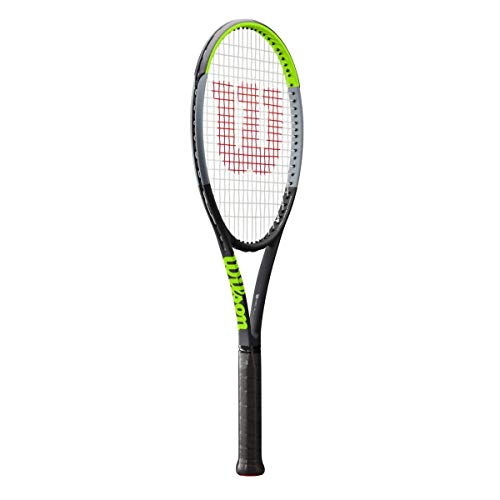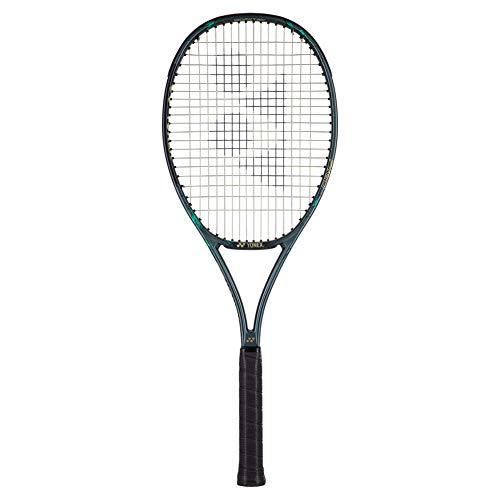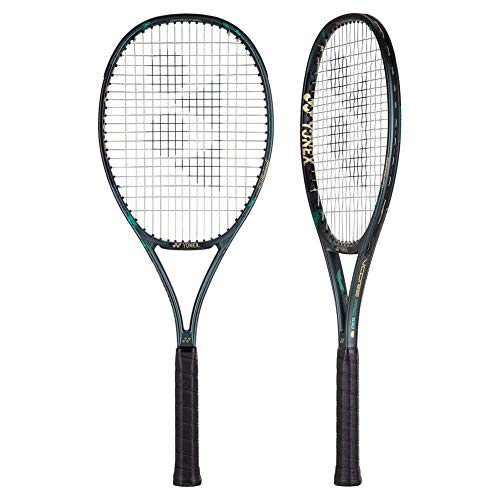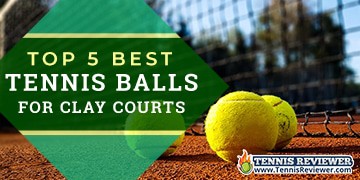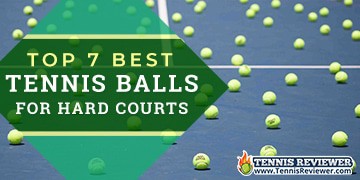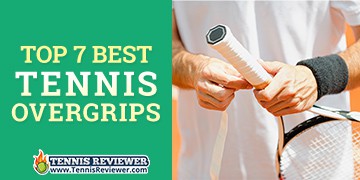Tennis can be an addictive sport whether you are playing it yourself or watching your favorites smash the ball around back and forth. But nothing is more frustrating than having to do with nagging pain in your elbow. Tennis elbow is a common injury along with golfers elbow and should be treated seriously.
Don’t fret if you start to get it because tennis elbow is not a career-ending injury. Often tennis elbow can be corrected by playing with a number of specs on the racket to make it more arm-friendly.
Here is the list of the top 7 rackets that work best when someone is dealing with tennis elbow.
But first, let’s understand why these rackets make good fits and what you should look out for when choosing a racket.
Table of Contents
In a Hurry? Here’s Our Top Picks…
| Image | Title | Buy |
|---|---|---|
 | YONEX EZONE 100 Deep Blue Tennis Racket | Buy Now |
 | Wilson Blade v7 98 Tennis Racket | Buy Now |
Top | Wilson Clash 100 Tennis Racket | Buy Now |
 | HEAD Graphene 360+ Prestige MP Tennis Racket | Buy Now |
 | Babolat Pure Strike Tennis Racket | Buy Now |
 | YONEX VCore Pro 100 Tennis Racket | Buy Now |
What Makes A Racket Good For Tennis Elbow?
When it comes to buying a racket, it’s easy to feel like you have no idea where to start. There are so many rackets on the market, and they all feel so different that it can be difficult to understand why. What makes a difference for those who have tennis elbow will be weight, weight distribution, stiffness, and more. Choosing a racket that passes these areas will be critical to maintaining the injury.
It’s a game of balancing specs as the racket’s weight has both pros and cons depending on which direction you go. For instance, a heavy racket can provide extra stress on your arm if you have bad technique, but a light racket may move too much in your hand upon contact.
The level of stiffness will absolutely make a difference as well. An RA rating is a calculation that a manufacturer will provide to let you know how much give a racket has. A stiffer racket is going to be, in general, bad for your tennis elbow.
Knowing these categories and what specs will make a difference in playing will also make a difference in your arm’s feeling. Sometimes the racket you think you want isn’t the racket you need.
Below is a total breakdown of all the things that make up a racket and how to properly pick the specs that fit your needs.
Four Types of Rackets
Manufacturers can make rackets that fit into four different categories of rackets. These categories essentially fit three types of players, but ultimately each category has a different impact on the arm.
These types of rackets can be referred to as power rackets, modern rackets, tweener rackets, and lastly, traditional player’s rackets. Each category follows a general guideline of specs however even two rackets in the same category can differ with specs.
As a general rule of thumb, tweener rackets tend to be the best when it comes to being arm-friendly and traditional rackets are usually a no-go. Keep in mind that each racket can be customized to a degree to make a racket more or less better for your arm.
Power Rackets:
These rackets are a great option when it comes to treating tennis elbow kindly because they are oversized in nature. This means that a power racket will generally have a bigger sweet spot. Bigger sweet spots have more forgiving contacts as you can hit off-center more, and it will still feel ok.
Even though they are larger rackets, they tend to be overall a lightweight option. This is great because it puts a lot less stress on the joints. The only downside to this is the lighter rackets can send more vibration to the arm because of the instability it may face in the hand upon contact.
Modern Racket:
These rackets fall into the mid-plus size category being a little bill smaller than a power racket. This will still offer a decent size sweet spot because the racket size will be slightly bigger. This sweet spot will be smaller than power rackets but still have a forgiving feel to provide comfort to the arm.
This racket is great for more advanced players because they won’t need as big of a sweet spot because they’re more skilled to hit on the center of the racket.
Traditional:
These rackets are really meant for professional and advanced players. This is because the frame size is the smallest. This also means that it is the smallest sweet spot, and off-center shots will feel bad. They are also heavier and stiffer rackets which are triple whammy to the arm.
The plus side you will get from having a heavier racket is that the instability issue goes away. However, it can cause more stress on the joints, and combined with the stiffness levels, it can be difficult. For someone who has tennis elbow, this racket is not recommended.
Tweener:
Tweener rackets tend to be what more intermediate and advanced players use because of their ability to have great playability and a well-rounded feel. The specs tend to go right down the middle of everything, and they are usually medium-heavy rackets. This can seem like a downer, but actually, many are offered in light swing weights.
These tend to be a great option for everyone because of what they have to offer in comfort and playability.
Weight
Weight plays a really important role when it comes to how your arm is going to feel when playing. This is even more important when you already deal with tennis elbow problems. Heavier rackets will add stability and transmit less shock for the most part.
Keep these two things in mind when thinking about playing with a heavy racket.
Heavy weight can be tough on players who deal with tennis elbow. When increasing weight in the racket, it’s normal to feel slightly sore for a few different days, but this is entirely different from having elbow pain. The heavier weight can assist in stabilizing the racket but may provide stress on your joints.
This is especially true for players who may have bad technique. It’s important to have good technique when upping the weight, or the feeling of elbow pain can increase. The only good thing is for those who have good form heavier rackets, if not too stiff, will be more stable and absorb some of that shock.
Lightweight rackets can take away some of that stress on the elbow but can cause instability in one’s hand that would lead to pain. This is because the force of the ball takes over the racket.
Head Size
Head size also has a lot to do with how much shock will be transmitted to your arm. This is because head size has a lot to do with how big the sweet spot is. This is directly related to how forgiving a hit will feel on your joints.
This makes a big difference for those who aren’t as advanced and don’t hit on center every shot. You won’t get that shocking contact feel that will send unwanted vibrations through the racket and to the elbow.
There are four categories when it comes to head sizes. Each category ranges in level of play and needs of the tennis player.
- Midsize
- Mid-Plus Size
- Oversized
- Supersize
Midsize:
These rackets really aim for professionals. They are often the traditional rackets that an advanced player will love. Because of their size, the need that they fill is control over power. These rackets tend to be stiff as well. Ultimately these aren’t a great choice for those suffering from tennis elbow. However, many of these rackets now offer dampening technology.
The frame itself is 84-97 square inches. These are the smallest frames offered on the market.
Mid-Plus Size:
This is one step up and can be a great option for players who still fall in the intermediate to advanced category. The increased frame size increases the sweet spot, which gives a slightly more forgiving feel. These rackets can be stiff or flexible depending on which racket you choose.
This racket frame is 98-105 square inches.
Oversize:
These rackets are usually more reserved for recreational players. This is because the head size tends to be quite large. They are overall lighter rackets but usually offer great power. For someone suffering from extreme elbow pain, this is not a bad option.
The larger head size will forgo a lot of your control and the dimensions for oversize rackets are 107-115 square inches.
Supersize:
This category is technically the best option when it comes to choosing an arm-friendly racket. However, they are way less common and naturally geared to people who play doubles and are much older that need a bigger sweet spot and added power.
Keep in mind that rules state that the racket head size can not exceed 12.5 inches in width and 15.5 for the hitting surface area.
String Tension
Going with the recommended string tension range is really important when dealing with arm health and tennis elbow. However, it’s essential for those dealing with pain in their arm to keep the tension on the looser side. This is definitely because the tighter the strings are, the more tension to your arm you will feel.
When the strings on the racket are looser, less effort can be applied. The strings also will do a better job absorbing the ball rather than feeling the contact a lot more closely. The string tension range to try and follow would be best if strung between 48 pounds and 53 pounds.
Balance
Balance is a really important spec to consider when you are dealing with elbow pain. There are three different balances to consider.
- Head Heavy
- Equally Distributed
- Head Light
Head Heavy rackets sound just like it is with the weight of the racket staying towards the loop of the racket, specifically towards the top. This racket will have more power and be a little more difficult to maneuver because of this weight distribution.
Head heavy rackets can be beneficial because they tend to have less shock that gets transmitted to the arm because it’s more stable. Another bonus of this weight distribution is that they tend to be lighter rackets overall.
Equally distributed weight is like a tweener racket where it offers the best of everything. This is great for players that need an arm-friendly racket but need a balance between power/control and maneuverability.
Head Light rackets are more often than not the worst rackets for anyone with tennis elbow that needs relief. This is because the weight is distributed to the handle, meaning the racket’s head will be unstable during contact and cause vibrations that will go to your elbow. Another problem is that these rackets tend to be heavier overall and can cause unwanted stress to the joints.
Swingweight
A racket’s swing weight is slightly different from the actual weight and the balance of a racket. This spec is not the end all be all for those with tennis elbow, but it plays a role in how things feel for sure. The number is a calculation based on the actual weight and its balance. It’s more about how heavy the racket feels rather than what it actually is.
The swing weight comes directly from the balance of the racket as head light, and head heavy racket in combination with its actual weight will produce different ratings. This is what matters when dealing with tennis elbow.
The swing weight of a racket will increase when the weight gets put at the top of the racket. This means that head heavy rackets have a higher swing weight than a head light racket. Think about how it would be more difficult to lift a pole with a weight on the end of it. Then think about lifting the weight with a pile attached. The latter is easier.
Stiffness
Stiffness is one of the most important things to think about when choosing a racket that will not bother your tennis elbow. A stiff racket is a bad choice for anyone who needs relief as it will cause a lot of shock to the arm. You can’t make a racket less stiff, but you can deal with different technology vibrations.
When a racket has more flex, it will bend backward then forwards upon contact. This is something that can only be felt and not seen with the naked eye. The more a racket bends, the better absorption you will have, and the shock will be much less.
The stiffness is measured in a form called an RA rating. This number is done by the manufacturers and can let anyone know what they are buying. Typically it falls between the range of 50-70.
The Top 7 Best Tennis Rackets For Tennis Elbow 2022
This information can feel like a lot at first. Once you understand how the specs play off of eachother and make a racket more or less suitable for your needs, you will start to feel a lot better. Plus you can use this info with the list below to pick out the perfect racket for you.
When looking at rackets manufacturers will break down the different specs of the racket and explain why it may be more or less powerful, or more or less flexible. This list will also provide that information to you.
However there are so many options still on the market that it can still feel overwhelming. This list below are the absolute best options for tennis rackets that work well with tennis elbow.
1.Yonex Ezone 100
Yonex Ezone 100 is a very comfortable racket for intermediate to advanced players who deal with tennis elbow. The feel is great, and its flexibility provides awesome power. The next weight class up of the Yonex Ezone is the 98. This racket is not a great choice for those with tennis elbow because it’s too heavy as well as stiff.
Those who know how to control a powerful racket will love the Yonex Ezone 100. It has a smaller frame for control but a great sweet spot. This is because of the frame.
It has a different unique head shape. It is a rectangular frame but somehow offers a decent size sweet spot. This means it has a down the middle feel for how forgiving the racket is. The racket also includes M40X in its throat, which helps dampen vibrations and ease the arm’s shock.
To make unforgivable shots even less common, the grommets are lined with technology to reduce the friction from the strings to the frame. This will be particularly helpful for those who have tennis elbow.
The Breakdown:
- The Ezone has an unbelievable playability and ranks high in all areas from groundstrokes, volley, and serves.
- It is a relatively stiff racket as it comes close to the max stiffness at 70. This is why the vibration-reducing technology is important.
- The power from the stiffness is controlled through a smaller frame.
- Anti-shock system offsets the vibrations that would be felt through a stiff frame.
- One of the more versatile performance rackets on the market gets updated for 2020.
- M40X For Improved Stability and Flex
- Vibration Dampening Mesh
- Largest Sweet Spot in Ezone History
2. Wilson Clash 100
The Wilson Clash is said to be fierce competition to the Yonex and is possibly even better when it comes to offering elbow pain sufferers relief. This is due to its Freeflex and Stablesmart technology that Wilson incorporated.
The freeflex technology works so that the frame bends at the perfect balance when the ball makes contact with the strings. This will absorb the ball better. It’s paired with Stablesmart technology that reduces the vibration and shock that comes from a lighter racket.
It’s lightweight and is very maneuverable as it weighs under 11 ounces when strung. This may concern a player normally with instability issues, but the technology really balances it out. Some players also appreciate a lightweight racket because of the stress a heavy one may cause.
The Breakdown:
- Wilson prides itself on this racket being 215% more flexible than the next leading racket.
- It’s a 100 square inch frame making it a great in-between racket.
- Its 55 RA stiffness rating pulls in at the lower side of stiffness.
- Its swing weight is 312 grams matching the exact strung weight so that it feels just as it really is.
- The Clash 100 matches all the hype through a combination of best-in-class control and flexibility. This is achieved through a head-light balance in conjunction with FreeFlex, an all-new technology that features proprietary carbon mapping - a construction that allows the frame to bend in new dimensions for ultimate ball pocketing and added dwell time
- StableSmart frame geometry preserves the stability through the swing, creating a racket that achieves extraordinary flexibility with best-in-class stability. Join the racket revolution and reach levels of confidence in your game that youve never felt before
2. Head Graphene 360+ Prestige
Manufactured by one of the leading brands on the market, the Head Graphene 360+ is a perfect choice if you are suffering from tennis elbow. Coming with a head that is set at 98 square inches as well as a 4.5-inch grip it is a powerful and comfortable racquet to play with. While you may consider it to be a smaller version of professional tennis racquets, this product is suitable for tournament use.
Most importantly, it is the sleek design that goes a long way in terms of improved accuracy as well as the ability to wield and hit a tricky shot without investing as much physical effort. In addition to that, you will find that it comes with a flexible frame which goes a long way in terms of minimizing torque and stress placed on your elbow and wrist.
The graphite design of this racquet ensures that you can use it on a daily basis without having to worry about the common tear and wear. Furthermore, it is a racquet that allows explicit control which is why we consider it to be a good choice for players of all skill levels.
- Coming with a 4.5-inch grip and a 98 square inch head
- Perfect for players of all skill levels
- Requires less effort to wield and hit tricky shots
- Features a flexible frame for an even weight distribution
- Made with durable graphite for minimizing tear/wear
- HEAD PEDIGREE: Born out of revolutionizing how we ski and play tennis, HEAD has constantly pushed athletic equipment into the modern era. For all levels of play, HEAD offers nothing but top tier tennis equipment.
- MP PERFORMANCE: The HEAD Prestige Midplus graphite tennis racket is an ideal choice for a wide range of more serious players. The iconic racquet is still one of the best options for advanced player seeking surgical accuracy.
- UNPARALLELED SHOTS: The adult tennis racket boasts unmatched energy transfer and clean impact feel thanks to spiralfibers throughout the racquet.
- DURABLE GRAPHENE: Made with a durable and lightweight graphite spiralfiber technology, this is a professional level tennis racket built to last.
- DIMENSIONS: Frame Weight: 320 g /11.3 oz, Head Size : 98in, Grip Size: 4 1/2in, Length: 27in.
3. Babolat Pure Strike (16×19)
The Babolat Pure Strike Tennis Racket boasts an exceptional shock absorption level thanks to the Woofer Dynamic String System. As a result, many people consider this the greatest tennis racket for tennis elbow. Babolat features the perfect combination of an elliptical and a square frame which seems to be just perfect if you are looking to play an offensive tennis game without exerting as much physical effort in your shots. The reactivity and accuracy of this racquet will allow you to hit complex spins with more control.
Discussing the head, it is set at 98 square inches while you can choose from a wide variety of grip variations including the 4.12-inch, 4.25-inch, 4.5-inch, as well as the 4.75 inches if you require a larger racquet. Carbon fiber is a classic and a material that ensures great resilience for everyday use.
The string pattern on this racket will help you generate a lot of spins. Because the soft frame is composed of graphite, there’s no reason to be concerned about its arm-friendliness. One of the coolest points of this racquet is that you can get your racquet strung by the company for absolutely free.
- Offers superb reactivity and accuracy when hitting complex spins
- Made of carbon fiber, making it suitable for everyday use
- Comes with a few grip sizes including 4.12-inch, 4.25-inch, 4.5-inch, and 4.75-inch
- Suitable for players with an offensive game style
- Durability: Babolat RPM Blast
- Playability: Babolat Xcel
- Hybrid: Babolat RPM Blast /
4. Wilson Blade V7 98
The Wilson Blade V7 98 is a popular choice among tour players. It’s a head light racket with a flexible frame that provides an incomparable feel when striking the ball.
This racket got rid of Wilson’s well-known Countervail technology and instead used the new Feelflex tech to add to the racket’s stability upon striking. This is why it’s a great option for those with tennis elbow.
The great part about this racket is that it seems to do well with every shot. The overall playability is high. Control is the focus of this racket which can be a sign for someone with elbow pain to stay away. But this racket incorporates so much of its vibration dampening technology it offers the best of both worlds.
The flexibility of the racket also dampens some of the power but provides a lot of comfort to the elbow, arm, and shoulder for players who tend to swing big. It’s a dense 18×20 string pattern and a light racket strung at just over 11 ounces.
The Breakdown:
- A flex frame offers maximum comfort and less vibration to the arm.
- Its overall light frame has easy maneuverability allowing players to swing hard and fast.
- Control, stability, and power are rated high in all categories making it an all-around great choice for intermediate to advanced players.
- The higher swing weight with the light racket is what makes the head heavy racket feel like it has juice and stability behind it.
- Wilson`s Blade 98 v7 Tennis Racquet represents a bold new direction for the Blade franchise.
- FeelFlex
- Top Grip Taper
- Reduced Spec Variance
5. Head MicroGEL Radical Midplus
The HEAD MicroGEL Radical Midplus is made with those who have serious elbow pain in mind. It’s a version of the Radical that protects the elbow as much as possible. This is because it incorporates MicroGEL technology throughout the racket frame to really soften the contact and vibration that moves to the arm.
The way it works is that upon contact, the microgel will compress and decompress among contact to absorb the vibration and also provide a solid contact feel. This is truly a unique technology and can be really felt when hitting.
The flex to the frame of the racket is also a lot that is greatly appreciated when making contact. Its swing weight is 315 grams makes it feel like it’s maneuverable and solid at the same time. This might be surprising considering its stiffness level.
Its stiffness level is middle ground at 62, which contributes to the flex combined with a low power level, allowing players to really swing free and fully create their own power.
The Breakdown:
- Its 98 square inches in head frame makes it a slightly smaller head size than some of the other arm-friendly rackets.
- It weighs in at 11 ounces and has a slightly higher swing weight of 315 grams.
- Its recommended stringing tension is 52-62 pounds putting it at a more normal range because of its microGEL tech.
- Its stiffness rating comes in at 62, making it slightly more stiff than some of its other competitors.
- For aggressive players with hard strokes
- 98 head, 11.1 oz strung, 3 points head light, 18 x 20 pattern
- For all court Play
- Cover for one racquet. Shoulder Strap. Lightly padded to Prot
6. Volki V Sense Pro V1
The Volki V Sense Pro V1 Pro is less commonly known as it’s not a brand that is in the top power manufacturers. However, it has a lot to offer. Especially those who struggle with tennis elbow. The 99.5 square inch head size powered with an 11.3 strung weight makes it arm friendly and offers a feel as good as the other rackets.
The Volki rackets are developed to assist those with arm injuries with no specs really sticking out compared to one another. This increases the playability of the racket. The only thing to consider here is that the racket moves really well but can have a tiny bit of instability because of this.
This provides long-term comfort to the arm but may have a little shock from off-center hits during contact. Its swing weight comes in at 317 grams which actually makes it feel lighter than it actually is. But not by much. This is important when it comes to balance.
It’s a head light racket but not by much, with only 3 balance points head light. This is what makes the racket so easy to swing fast, and while it may be slightly heavier, the weight is in the right place for arm-friendly swinging. It’s counterintuitive to some of the advice above, but it’s only slightly head light. It offers a good alternative to some of the other rackets out there.
The Breakdown:
- A different frame size of 99.5 square inches puts this racket pretty down the center when it comes to head size.
- The weight is 11.3 ounces with string but has a lighter swing weight of 317 grams, increasing maneuverability and instability.
- 16×19 mains and crosses is the string pattern.
- It rates pretty well on all aspects of power to maneuverability, not really shining in one category over another.
7. Yonex VCORE Pro 100
The Yonex VCORE Pro 100 is a surprising choice at first for those who have tennis elbow. But once getting into the specs, this racket can make a lot of sense for those trying to preserve their elbow.
You can immediately expect less shock to the arm as the dampening vibration mesh is incorporated into the handle of the rackets. This is a great feature that Yonex has for their rackets to combat their stiffness levels and small frames. This feature alone can be a great sell for those who are prone to tennis elbow.
The swing weight was increased to 323 and had an overall stiffness rating of 65, making it a slightly stiffer racket than some. Its 11.2 ounces for weight makes it not a very heavy racket and easy to swing. These features counteract with each other to balance out some of the specs that could aggravate tennis elbow.
Like many other rackets, it is a standard 27-inch length that is optimal for intermediate to advanced players with a 16×19 string bed. While the frame size is small like the other rackets coming in at 98 square inches, the sweet spot is generous due to its unique size.
The Breakdown:
- Despite a stiff frame, Yonex adds dampening technology to the throat of their rackets, offering much less shock to the arm and elbow.
- The emphasis is on control and accuracy, allowing players to take full swings and feel comfortable doing so.
- Lock Booster grommets are used throughout the racket to promote better energy transfer from the ball and make the racket more spin-friendly.
- As with all Yonex rackets, the shape offers a smaller head with a better positioned sweet spot because of its shape.
- Yonex is has updated one of the most popular frames on the pro tour with the Yonex VCORE Pro 100 (300g) Green Tennis Racquet.
- Vibration Dampening Mesh
- Namd
- Matte Green
FAQ:
Even though that is a great list of rackets that deal best with tennis elbow, it’s still natural to feel like some things need to be answered. Especially with tennis elbow and trying to figure out what factors will make things better and worse.
Continue through these frequently asked questions to get a complete picture of why these rackets listed above are the best on the market for players with elbow injuries.
What is/Why is the life expectancy of a racket important?
The USTA will tell you that a racket can last around two years. It’s important to really monitor yourself as the life expectancy can really change depending on how much you play and how much physical distress the racket takes. A racket that endures a lot of stress can start to lose its specs and then cause your arm’s problems.
The more the racket changes, the less ideal it will be for your tennis elbow. This is because the vibration technology can start to wear. Also, the balance can change, which is an important factor when choosing a racket. The more a racket is strung, the more the strings will pull and warp the frame changing the balance and the sweet spot.
Maintaining a racket is really important to your arm’s health. When it starts to feel funny, it’s a good idea to look into starting to get new rackets. If your tennis elbow starts to act up more, then it is likely that your racket may have experienced too much wear and tear.
Does it matter which strings I use when stringing my racket?
The stings you play with quite literally play a major role in your arm health and maintaining your tennis elbow. The reason being is that most people who have tennis elbow can’t play with the more common strings because they aren’t soft enough. While they are more affordable and break less often, they aren’t a great choice for those with elbow pain.
Soft strings provide an awesome feel which explains why they are so pricey. They also provide amazing comfort because of their absorption. The only downside to this is they can break quite frequently, which makes it not so fun considering they come at a high price point.
Natural gut is the best option for those looking for a really soft string and for those who deal with a lot of elbow pain. It is also one of the most expensive strings on the market. The reviews, however, are high, and a lot of people say it’s really worth the investment.
What are the weight classes of rackets and how does it affect my arm?
An individual racket will have multiple weight classes for a player to choose from. A great example is the HEAD Gravity. This racket will have the S, MP, MPLite, Pro, etc. The string weight will change, but the overall specs will remain the same. A person with tennis elbow will need to choose an appropriate weight they can handle for their elbow injury.
The other factor that can change between weight classes is the level of stiffness. This is to offer players who like the overall feel of the racket more or less control. For instance, the Yonex 100 is more flexible than the Yonex 98. The Yonex 100, as noted, will be a better option for those who experience elbow pain.
The heavier a racket is, the more strain it could have on your arm. Same with stiffness, as the stiffer a racket is, the worse it will be for your arm’s health. However, a heavier flexible racket can be a good combination in staying stable and adding power so that a player doesn’t have to produce too much of their own.
The weight distribution, for the most part, will remain the same within a model. As noted in this guide’s opening, paying attention to weight distribution is an important choice in preserving your elbow.
How do I know which tension to string my racket at?
A racket manufacturer will list the range online and sometimes even on the racket. Keep in mind the lower in tension you go, the better it is for your arm. Loose strings allow for more absorption, while stiff strings offer more control.
It’s best to tamper with a tension that both finds comfort and control as most players have their own preference. A tension preference may also change from time to time, depending on the conditions one plays in.
What is the recommended level of stiffness for players?
The lower the stiffness rating, the better it is for the arm. However, some people don’t like the lack of control that comes with the flex. Finding somewhere between 50 and 60 is generally a good range for players who struggle with arm issues.
Stiffness, however, is a personal preference for some people, and stiffness can be combated with different technology. For instance, as mentioned, Yonex puts a lot of mesh vibration technology in the head of the racket to dampen the blow upon impact.
Wilson does the same with its Flex Flexfeel and Stablesmart technology. These are the specs a player may play around with for comfort.
Conclusion
There is quite a lot of information to take in when it comes to choosing a racket that will continue to allow you to play comfortably. It’s important to really take this information into consideration as well as demo rackets. There is really no substitute for demoing a racket. This can easily be done at your local tennis shop or an online retailer like Tennis Warehouse.
Any racket that is meant for someone with tennis elbow must have technology built in to dampen the vibrations. This, combined with any kind of off-court care or braces and medical additions, can make for a better feel.
With this list and this information, you’ll be on your way to hitting more comfortably.
























